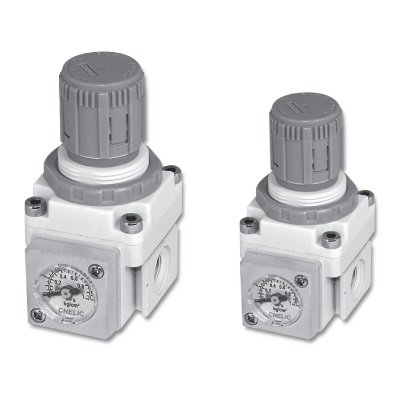2022-02-25
General Purpose vs. Filter vs. Precision Regulator

General Purpose vs. Filter vs. Precision Regulator
There are several types of air pressure regulators in different pressure ranges, materials, sizes, and shapes. These three categories include the general purpose regulator, filter regulator, and precision regulator.
Below is a short overview of each category.
Precision Regulators
The sensitivity and accuracy of precision regulators are the two things that set them apart from the general purpose regulators.
You can consider sensitivity as the ability of the regulator to react to air pressure changes relative to the set point of the unit. If a certain precision regulator has a sensitivity of 1/8” water column, this means that when the output pressure has a difference in set pressure of around, 0.0045 PSI, the unit is going to correct the output pressure to return to the set point.
This type of high sensitivity level can be achieved if the unit diaphragm of the unit is kept in a reactive state. This is also done through constant bleeding of a small quantity of air that doesn’t allow the diaphragm to settle.
Some of the most common applications of a precision regulator include microfluidics, calibration standards, web tensioning, medial OEMs, and ventilators.
General Purpose Regulators
General purpose regulators are more suitable selections if the main priority is the cost instead of precision. This type of regulator is typically used in many OEM applications. Unlike precision regulators that are often sensitive to 1/8” water column, general purpose regulators are sensitive to 0.036 PSI or 1” water column.
However, since these regulators have not been designed for bleeding a small amount of air, you will notice generally lesser consumption of air when general purpose regulators are used. These specific types of air pressure regulators are often used in the fluid power industry and process control panels and instrumentation.
Since these are regulators are more economic, these make good units for regulating individual service lines instead of the main shop airline that requires a unit with a better flow allowance.
Filter Regulators
Air pressure filter regulators are considered to be a critical air preparation device as far as protecting sensitive downstream equipment is concerned. The main purpose of filter regulators is to clean the airline of particulates and moisture while lowering the air pressure to a certain setpoint at the same time.
It is important when it comes to offering protection to expensive lab equipment, I/P transducers, or valve positioners. The regulating principles are similar here since these are all for the air pressure regulators.
The supply air is also forced through the sintered polyethylene filter that is either 5 or 40 microns in size for filtering out very small particulates and moisture from the supply air. All the things that have been filtered out from the air get captured in the drip well and could be either automatically drained or manually drained every time the fluid has hit a specific point.
All filter regulators have a sensitivity of 1” water column and are available in stainless steel or aluminum as well as non-relieving or relieving.
- Air Source Units
- Control Valves
- Miniature Cylinder
- Standard Cylinder
- Stopper Cylinder
- Dual Rod cylinder
- Compact Cylinder
- Slide Table Cylinder
- Guide Cylinder
- Rodless Cylinder
- Clamp Cylinder
- Gripper Series
- Rotary Cylinder
- Directional Control Series
- Vacuum Equipment
- Fitting/Auxiliaty Equipment
- Accessories
TAIWAN CHELIC CO., LTD.
TEL : 886-2-29041235
FAX : 886-2-29068203
No.21, Guifeng St., Taishan Dist., New Taipei City 243, Taiwan
